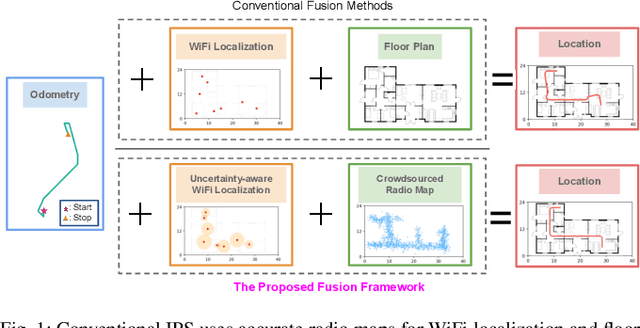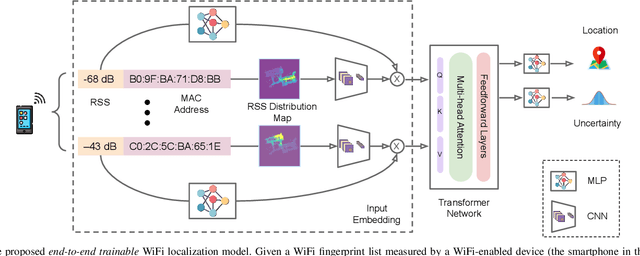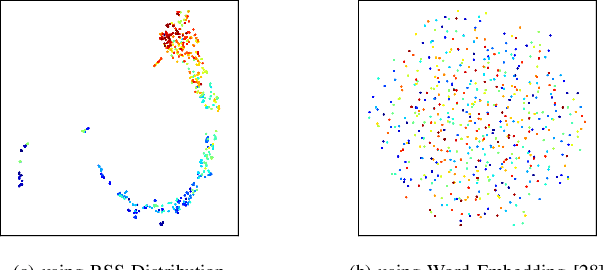Firas Alsehly
Multimodal Indoor Localization Using Crowdsourced Radio Maps
Nov 17, 2023



Abstract:Indoor Positioning Systems (IPS) traditionally rely on odometry and building infrastructures like WiFi, often supplemented by building floor plans for increased accuracy. However, the limitation of floor plans in terms of availability and timeliness of updates challenges their wide applicability. In contrast, the proliferation of smartphones and WiFi-enabled robots has made crowdsourced radio maps - databases pairing locations with their corresponding Received Signal Strengths (RSS) - increasingly accessible. These radio maps not only provide WiFi fingerprint-location pairs but encode movement regularities akin to the constraints imposed by floor plans. This work investigates the possibility of leveraging these radio maps as a substitute for floor plans in multimodal IPS. We introduce a new framework to address the challenges of radio map inaccuracies and sparse coverage. Our proposed system integrates an uncertainty-aware neural network model for WiFi localization and a bespoken Bayesian fusion technique for optimal fusion. Extensive evaluations on multiple real-world sites indicate a significant performance enhancement, with results showing ~ 25% improvement over the best baseline
Beyond KNN: Deep Neighborhood Learning for WiFi-based Indoor Positioning Systems
Feb 02, 2023Abstract:K-Neares Neighbors (KNN) and its variant weighted KNN (WKNN) have been explored for years in both academy and industry to provide stable and reliable performance in WiFi-based indoor positioning systems. Such algorithms estimate the location of a given point based on the locality information from the selected nearest WiFi neighbors according to some distance metrics calculated from the combination of WiFi received signal strength (RSS). However, such a process does not consider the relational information among the given point, WiFi neighbors, and the WiFi access points (WAPs). Therefore, this study proposes a novel Deep Neighborhood Learning (DNL). The proposed DNL approach converts the WiFi neighborhood to heterogeneous graphs, and utilizes deep graph learning to extract better representation of the WiFi neighborhood to improve the positioning accuracy. Experiments on 3 real industrial datasets collected from 3 mega shopping malls on 26 floors have shown that the proposed approach can reduce the mean absolute positioning error by 10% to 50% in most of the cases. Specially, the proposed approach sharply reduces the root mean squared positioning error and 95\% percentile positioning error, being more robust to the outliers than conventional KNN and WKNN.
WiFi Based Distance Estimation Using Supervised Machine Learning
Aug 15, 2022



Abstract:In recent years WiFi became the primary source of information to locate a person or device indoor. Collecting RSSI values as reference measurements with known positions, known as WiFi fingerprinting, is commonly used in various positioning methods and algorithms that appear in literature. However, measuring the spatial distance between given set of WiFi fingerprints is heavily affected by the selection of the signal distance function used to model signal space as geospatial distance. In this study, the authors proposed utilization of machine learning to improve the estimation of geospatial distance between fingerprints. This research examined data collected from 13 different open datasets to provide a broad representation aiming for general model that can be used in any indoor environment. The proposed novel approach extracted data features by examining a set of commonly used signal distance metrics via feature selection process that includes feature analysis and genetic algorithm. To demonstrate that the output of this research is venue independent, all models were tested on datasets previously excluded during the training and validation phase. Finally, various machine learning algorithms were compared using wide variety of evaluation metrics including ability to scale out the test bed to real world unsolicited datasets.
 Add to Chrome
Add to Chrome Add to Firefox
Add to Firefox Add to Edge
Add to Edge